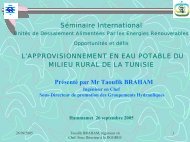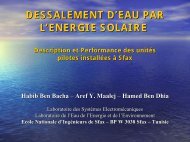Energy consumption modelling - ADU-RES
Energy consumption modelling - ADU-RES
Energy consumption modelling - ADU-RES
Create successful ePaper yourself
Turn your PDF publications into a flip-book with our unique Google optimized e-Paper software.
Discussion<br />
The proposed well pump is rather inefficient. It is a small centrifugal pump, operated well away form its best-efficiency point, driven<br />
by a small single-phase induction motor, also operated away form its best-efficiency point.<br />
The well pump’s main task is to lift the water just 4 metres; this head corresponds to just 0.02 kWh/m 3 , whereas the electricity<br />
consumed by the well-pump motor is 1.43 kWh/m 3 . A small proportion of the energy (0.25 kWh/m 3 ) is passed to the plunger pump,<br />
and will serve to slightly reduce the load on its motor, but the rest of energy is simply lost.<br />
The proposed well pump illustrates how seemingly small devices can have a significant effect on overall energy efficiency.<br />
On the other hand, the well pump plays an important role, not only lifting the water, but also pushing it through the pre-filters and<br />
preventing cavitation in the plunger pump. Furthermore, centrifugal pumps are generally very reliable and require minimal<br />
maintenance. Finding a suitable alternative pump is not at all straightforward.<br />
One suggestion is to use a much bigger pump to quickly fill a header tank. Being larger would greatly improve the pump and motor<br />
efficiencies. Moreover, having a header tank would allow the two motors to run independently, and this could be exploited by the<br />
controller so as to reduce the energy going through the batteries, which would bring a further significant energy saving.<br />
<strong>ADU</strong>–<strong>RES</strong> WP6 Deliverable 6.1 Page 30 of 69







